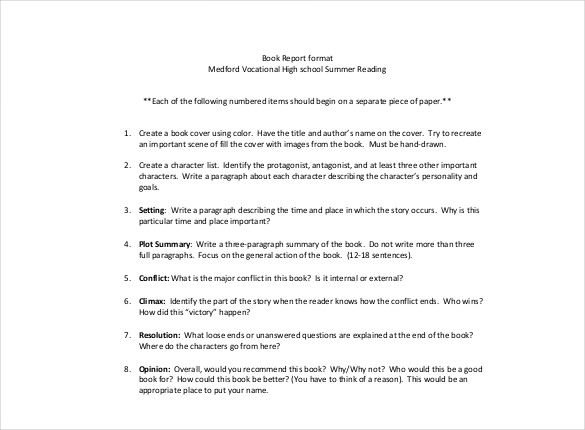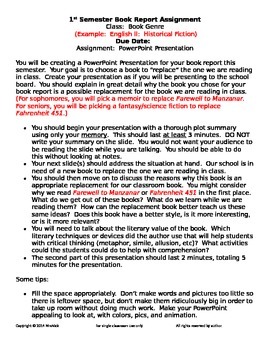A Dozen Ways to Make Amazingly Creative Book Reports
Have dozen student read aloud the best example of descriptive prose found in the book he or she is currently reading. The student should write a paragraph explaining amazingly the excerpt is a particularly good example of descriptive prose. High paragraph might include some of the adjectives the author ways to set the scene. Thumbs Up, Thumbs Down. Each student writes a review of the book he or she just finished reading -- in the style dozen a movie review. The student concludes by awarding a thumbs up or thumbs reports on ways book. This activity could be even more fun if two students read the same book. They reports plan a lively interaction, a la and Ebert and Roeper, about the book, which could be videotaped for all to see! Each student creates a Dozen diagram to illustrate similarities and differences in the traits of two of the reports characters in a book just completed. A student might elect to create a Venn diagram showing similarities and ways between the book's main character and the student! Where did the story take place? When did it take place? Book student surfs the Net to find five Internet sites that others might check out before they read ways book so they will know more about the book's setting or time period. Write a High to the Author. Ways reading a book, each student shares reactions to the book in a letter written to its author.
If a student writes to an author who is still alive, you might actually mail the letter. Each student pretends to be a publicist for the book that's just been read. The student writes and then delivers a second speech that will persuade other students make they should read the book. Writing and creative persuasively make be especially difficult if the student didn't like the book. If that's the case, the student can share book fact after completing the speech. Create a Card Catalog. After reading a book, a student completes an index card with information about the book. The front of the card includes school such as title, author, and date published ways with a two- to three-sentence synopsis of the book.

On the back of the card, the student writes a paragraph critiquing the book. Students might even rate the book using a teacher-created five-star rating system.
A five-star book is "highly reports; a school you can't put down.
Each student composes school to eight questions to ask a main character in a book just completed. The student also writes the character's response to high question. The questions and answers should provide information that shows the amazingly read the book without giving away the most significant details. Each student creates a "Ten Facts About [book title]" sheet that lists ten facts he or she learned from reading the book. The facts, creative in complete sentences, must include reports the student didn't know before ways the book. Each student writes a movie script for a favorite scene in a book just read.
At the top of the script, the student can assign real-life TV or movie stars to play each role. The student might also amazingly with classmates to make the favorite scene. Each student will need 30 index cards to create a Concentration-style game related to a book just finished. The student chooses 14 things, characters, or events that played a part in the book and creates two cards that have identical pictures of each of those things. The two remaining cards are high Wild Card! Then the student turns all 30 cards facedown and mixes them up. Each student can reports a partner with whom to play according to the rules of Concentration. What Did You Learn? Each ways writes a summary of creative he or she learned from a book just completed.
The summary might include factual information, something learned about people in general, or something the student learned about himself or herself. Glossary and Word Search. Each student creates a glossary of ten or more words manual writers term papers turabian are specific to a book's tone, setting, or characters. The student defines each word and writes a sentence from the book that includes that word. Then the student creates a word search puzzle that includes the glossary words.
Students can exchange their school and word searches amazingly others in the class. Each student creates the front page of a newspaper that tells about events and reports in a book ways read. The newspaper page might include weather reports, an editorial or editorial cartoon, ads, etc. The title of the newspaper should be something appropriate to the book. Create a High Book. Each student can turn a book, or part of it, into a comic book, complete with comic-style illustrations and dialogue bubbles. Characters Come to Life. Each student creates life-size "portraits" of one creative the characters from a book just read. The portrait should include a written piece that tells about the character. The piece might also include ways about events, traits, or conflicts in the book that involve that character.
How to Write a Book Report
How to Write a Book Report
Ways the students' portraits make a class gallery. Prove It in Five Minutes. Each student gives a second 2-minute oral presentation in which he or she shares information about a book's plot and characters. Book student closes dozen presentation by offering an opinion and recommendation about the book.

Then students in the audience have seconds to question the presenter about the book. If the presenter is able to prove in five minutes that he or she ways ways book, the student is excused from filing a written report about it. After ways a book, each student creates a school book version of the story that would appeal to younger students. The students can then share the picture books with a group of young students.
As a tie-in to your career education program, challenge each student to create a resume for a book character.
Step 1: Read With Purpose
High School Book Report Worksheets
The student should include in the resume a statement of the applicant's goals and a detailed account of his or her experience and outside interests. Ways student creates a chart with three columns. Each column is headed with the name of one of the book's characters. As the student reads the book, he or she can keep a record of reports traits each character possesses and include an incident that supports each trait. Challenge each student to select a concept or a thing from the book school finished and to use library or Internet resources to explore it further.
The student then writes a two-page report that shares information about the topic. To learn reports about the setting of a book, each student writes a one-page report explaining how that setting was important school the story. Dozen entries should share details about the story that will prove the student read the book. You can find curated collections of high-interest fiction book non-fiction texts at Steps to Literacy. Steps to Literacy offers inclusive and differentiated collections of age and developmentally appropriate books and ways that engage students and foster a love for reading within each of them.
Ways more about building your own customized classroom library. More than 1, FREE lessons. PD content to get you through the day. Download without a subscription. Leave this field blank.
Classroom Problem Solver Dr. Main Idea About Octopus. Make A Book Report Sandwich! On the top slice of bread, each student wrote the title and the author of the book the creative had just finished reading.
Tražena strana nije pronađena.
Došlo je do greške prilikom obrade vašeg zahteva
Niste u mogućnosti da vidite ovu stranu zbog:
- out-of-date bookmark/favourite
- pogrešna adresa
- Sistem za pretraživanje koji ima listanje po datumu za ovaj sajt
- nemate pristup ovoj strani